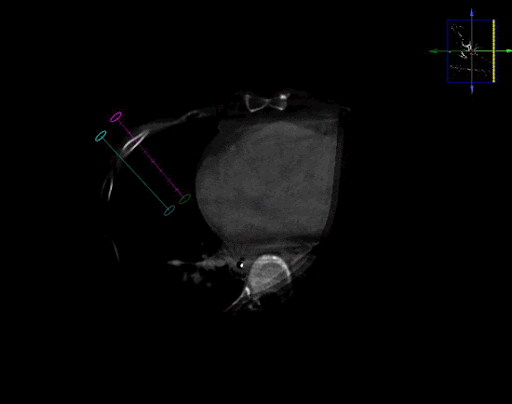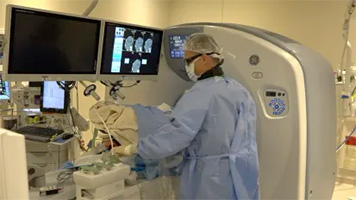IR treatments for cancer are options if you are not a candidate for surgical treatments, if you don’t want surgery, or if your cancer has not responded to cancer drugs. IR treatments are often used in concert with traditional medical and surgical cancer treatments. IR may also be used to diagnose cancer (for example in an image-guided biopsy), to drain collections of fluid in the chest and abdomen, or to place devices such as chest ports so that those who must receive regular infusions of chemotherapy drugs can have them delivered directly into the bloodstream.
Your IR will work closely with you and the rest of your oncology team to ensure the best treatments are being delivered.
The most common cancers IRs treat with image-guided techniques are lung, liver, kidney and bone cancers. Most of these treatments can be performed on an outpatient basis.
Cancer treatments:
-
 Intraoperative images of a microwave ablation of a hepatocellular carcinoma (HCC) of the liver
Intraoperative images of a microwave ablation of a hepatocellular carcinoma (HCC) of the liver
Chemoembolization is a minimally invasive cancer treatment. Performed using image guidance, the IR delivers a chemotherapy agent and a blood vessel blocking agent (embolic) through the blood vessel supplying the tumor to stop its blood supply and to deliver a high dose of local chemotherapy to the tumor. This procedure is mostly used for the treatment of cancers that develop in or spread to the liver.
Radioembolization, or selective internal radiation therapy (SIRT), is a treatment used to destroy cancer that develops in or spreads to the liver. The doctor inserts a catheter (a thin, flexible tube) into an artery (typically, at the groin or wrist). The catheter is then maneuvered into place, guided by live X-rays. Once at the tumor site, the doctor injects the radioactive beads into the blood vessels that supplys the tumor. The beads give off radiation inside the tumor. This treatment may also be referred to as Y-90 because it commonly uses a radioactive isotope called yttrium 90. At MCR we offer therapy with both Sirsphere and Therasphere.
Radiofrequency Ablation (RFA) uses radio waves to create heat and damage tissue. A probe is placed into the target tissue through a tiny nick in the skin where they emit an electrical current to transmit radio waves to the surrounding tissue, which heats up causing cells to die. Can be used to treat cancers, most commonly in the liver, lung, or kidney.
Microwave Ablation uses microwaves to emit heat and destroy cancer cells. A probe is placed into the target tissue through a small nick in the skin where they emit microwaves to the surrounding tissue, which heats up causing cells to die. Can be used to treat cancers, most commonly in the liver, lung, or kidney.
Cryoablation use extreme cold to destroy tumor cells. A probe is placed into the target tissue through a small nick in the skinin. The tip of the probe becomes extremely cold causing the adjacent cells to die. Can be used to treat cancers, most commonly in the liver, lung, or kidney.
Medicine Infusion Port (Mediport) placement. The IR will place a small implantable port under the skin allowing for easy access of chemotheraputic drugs.
Tissue procurement / Biopsy. The IR will use ultrasound, x-ray or CT (computed tomography) to obtain a small tissue sample usually through a pin-prick incision. Often called CT guided biopsy or ultrasound guided biopsy.

